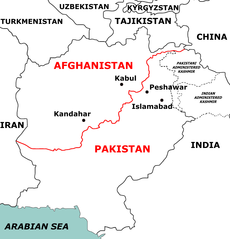杜兰线
杜兰线(英语:Durand Line,普什图语:د ډیورنډ کرښه、乌尔都语:ڈیورنڈ لائن)指巴基斯坦和阿富汗长达2430公里的边界分界线。它最先于1893年订立作为英属印度和阿富汗边界,由英国外交大臣莫蒂默·杜兰与阿富汗国王阿布杜尔·拉赫曼汗制定,定夺双方势力范围界限,并务求改善外交关系和贸易。
| 杜兰线 | |
|---|---|
 阿富汗和巴基斯坦政治地图(红线为杜兰线) | |
| 特征 | |
| 实体 | |
| 长度 | 2,430千米(1,510英里) |
| 历史 | |
| 创建于 | 1893年11月12日 第二次英国-阿富汗战争第一阶段结束时签署杜兰线协议 |
| 当前状况 | 1919年8月8日 第三次英国-阿富汗战争结束时签订《英国-阿富汗条约》 |
| 条约 | 甘达马克条约、杜兰线协议、英国-阿富汗条约 |
早于制定杜兰线以前,阿富汗的外交事务已受到英国箝制,在第二次英国-阿富汗战争期间签订的1879年《甘达马克条约》已经使阿富汗割让了奎达、皮辛、赫尔奈、锡比、古勒姆和开伯尔地区给英属印度。因为双方僵持不下,1893年11月12日英国外交大臣莫蒂默·杜兰作为英国女王全权代表与阿富汗国王阿布杜尔·拉赫曼汗在喀布尔订约划定。英国人以此作为阿富汗和英属印度的分界线;该分界线以当时的英属印度政府外交大臣莫蒂默·杜兰主持起草,以其名字命名。杜兰线把一半普什图族的家园划给英国。1901年,普什图族为主的西北边境省(North-West Frontier Province)设立了,在杜兰线英国的一边,而当地的一些土邦在保持与英国友好的前提下获允许保留自治权。但是和约签订后,瓦济里斯坦人等部落依然在反抗英国统治。[1]
1893年11月12日的单页协议共有七项条款,当中说明不可以干预界线的另一边。[2]1894年起英国与阿富汗共同制定停火线,占了边界的1300公里。[3][4]因应英国与俄罗斯之间的“大博弈”,杜兰线的制定等于让阿富汗成为两国在区内的缓冲区。[5]1919年《英国-阿富汗条约》对这条线作出了微调,并在印巴分治后由巴基斯坦自治领和后来的巴基斯坦伊斯兰共和国继承。
历史
编辑被杜兰线贯穿的地区,自古代以来已经居住着原住当地的普什图族。[6]在公元前500年左右,古希腊历史学家希罗多德提到早于公元前1千年阿拉霍西亚里面和附近已经居住着一个叫“Pactyans”的民族。俾路支部落住在线的南端,一个与普什图族分开的地区——俾路支斯坦。[7]
阿拉伯人于7世纪征服了当地,把伊斯兰教传给了普什图族。据指有部分早期的阿拉伯人在苏莱曼山脉与普什图族杂居。[8]历史中普什图族有“阿富汗族”的称呼,早至10世纪出现在阿拉伯语编年史里。[9]普什图族的地区(今称为普什图尼斯坦)先后被加兹尼王朝、古尔王朝、帖木儿王朝、莫卧儿帝国、汉达基王朝和锡克帝国统治。[10]
1839年,第一次英阿战争,英国带领的印度人军队入侵了阿富汗。两年后的1842年,战争以英国战败结束。1878年第二次英阿战争,英国再度入侵阿富汗。英国成功扶植阿布杜尔·拉赫曼汗为埃米尔,并于1880年签署《甘达马克条约》。阿富汗把大量前沿地区割给了大英帝国,加上要落实英国所需的地缘政治需要。
1893年,莫蒂默·杜兰获指派到喀布尔与阿布杜尔·拉赫曼汗制定协议,规范两国的势力范围,以及改善两国的外交关系与经贸来往。1893年11月12日,杜兰线协议达成。[2]双方之后到了阿富汗霍斯特附近的帕拉契纳,今天巴基斯坦开伯尔-普什图省(原联邦直辖部落地区)境内的一个小镇,勾画这一条边界线。杜兰线协议的正本由英文写成,翻译本为达里语。
协议的后果,就是英方多了一个行政区,称为“西北边境省”,今天它称为开伯尔-普什图省,包含了联邦直辖部落地区和边疆区。协议也使阿富汗获得努里斯坦省和瓦罕走廊。
由于杜兰线是英国入侵阿富汗时强加给阿富汗当局的,尽管它被国际认可为巴基斯坦西面边界,阿富汗一直极不愿意承认它。[11][12][13][14][15]当时英国人划分此线,目的是拆散使其畏惧的普什图族,至今,普什图人一半生活在巴基斯坦控制的边界一侧,另一半在阿富汗边界一侧。第一任阿富汗总统穆罕默德·达乌德汗曾经强烈地反对这边界并就此发动宣传战,但于1976年8月到访巴基斯坦时他就放软了态度,承认杜兰线是国际边界。[16][17][18][19][20]然而,之后的阿富汗政府仍然反对杜兰线为巴基斯坦—阿富汗边界。
2017年3月,巴基斯坦总理纳瓦兹·谢里夫下令重新开放巴基斯坦与阿富汗间的边界,以与阿富汗一同打击塔利班在边界的活动,而阿富汗前总统哈米德·卡尔扎伊明言阿富汗“永不承认”杜兰线是两国边界。[21]
2021年,阿富汗塔利班夺取政权后,阿富汗政府申明其人民跨越殖民时代边界且自由出入的权利。因此,它并不承认该线为国际边界,并将其视为阿富汗土地被英国占领后由巴基斯坦继承的分界线。塔利班上台一年来,与周边国家爆发了27次冲突,其中与巴基斯坦的冲突就有18次。阿富汗外交部边境管制委员会的一位消息人士称:“我们反对建造〈巴基斯坦-阿富汗边境〉栅栏,因为这会把居住在英国占领者划定的边界线两侧的阿富汗家庭隔开,我们不会允许这个计划完成。与此同时,巴基斯坦还希望沿线新建750个边境哨所。这对该地区居民和政府来说是一个非常敏感的问题。”此后两国关系再度恶化。[22]
参考资料
编辑- ^ Remembering the Faqir of Ipi. Asia Times. April 16, 2020 [April 17, 2020]. (原始内容存档于2020-12-16).
- ^ 2.0 2.1 Smith, Cynthia. A Selection of Historical Maps of Afghanistan – The Durand Line. United States: Library of Congress. August 2004 [11 February 2011]. (原始内容存档于2019-01-09).
- ^ "The total length of the boundary which had been delimited and demarcated between March 1894 and May 1896, amounted to 800 miles." The long stretch from the Kabul River to China, including the Wakhan Corridor, was declared demarcated by virtue of its continuous, distinct watershed ridgeline, leaving only the section near the Khyber Pass, which was finally demarcated in 1921: Brig.-Gen. Sir Percy Sykes, K.C.I.E., C.B., C.M.G., Gold Medalist of the Royal Geographical Society. A History of Afghanistan Vol. II. London: MacMillan & Co.: 182–188; 200–208. 1940 [5 December 2009].
- ^ An adjustment to the demarcation was made at Arundu in the early 1930s: Hay, Maj. W. R. Demarcation of the Indo-Afghan Boundary in the Vicinity of Arandu. Geographical Journal. October 1933, LXXXII (4).
- ^ Uradnik, Kathleen. Battleground: Government and Politics, Volume 1. ABC-CLIO. 2011: 18 [2020-06-28]. ISBN 9780313343131. (原始内容存档于2020-04-22).
- ^ Country Profile: Afghanistan (PDF). Library of Congress Country Studies. August 2008 [11 February 2011]. (原始内容存档 (PDF)于2015-07-14).
- ^ The History of Herodotus, Chapter 7. 由George Rawlinson翻译. piney.com. [11 February 2011]. (原始内容存档于2012-02-01).
- ^ Muhammad Qasim Hindu Shah (Firishta). History of the Mohamedan Power in India. Persian Literature in Translation. Packard Humanities Institute. [10 January 2007]. (原始内容存档于11 February 2009).
- ^ Baloch. Encyclopædia Britannica Online Version. [11 February 2011]. (原始内容存档于2008-01-08).
- ^ Kingdoms of South Asia – Afghanistan (Southern Khorasan / Arachosia). The History Files. [16 August 2010]. (原始内容存档于2019-03-27).
- ^ No change in stance on Durand Line: Faizi. Pajhwok Afghan News. 24 October 2012 [11 April 2013]. (原始内容存档于10 May 2013).
But Afghanistan has never accepted the legitimacy of this border, arguing that it was intended to demarcate spheres of influence rather than international frontiers.
- ^ Grare, Frédéric. Carnegie Papers – Pakistan-Afghanistan Relations in the Post-9/11 Era (PDF). October 2006 [11 February 2011]. (原始内容存档 (PDF)于2017-08-08).
- ^ Rahi, Arwin. Why the Durand Line Matters. The Diplomat. [9 September 2017]. (原始内容存档于2019-07-29) (美国英语).
- ^ Micallef, Joseph V. Afghanistan and Pakistan: The Poisoned Legacy of the Durand Line. Huffington Post. 21 November 2015 [9 September 2017]. (原始内容存档于2017-10-24) (美国英语).
- ^ Rubin, Barnett R. Afghanistan from the Cold War through the War on Terror. Oxford University Press. 15 March 2013 [2020-06-28]. ISBN 9780199970414. (原始内容存档于2020-04-22) (英语).
- ^ Rasanayagam, Angelo. Afghanistan: A Modern History . I.B. Tauris. 2005: 64. ISBN 9781850438571.
- ^ Dorronsoro, Gilles. Revolution Unending: Afghanistan, 1979 to present. Hurst & Co. Publisher. 2005: 84 [2020-06-28]. ISBN 9781850656838. (原始内容存档于2020-04-22).
- ^ Nunan, Timothy. Humanitarian Invasion: Global Development in Cold War Afghanistan. Cambridge University Press. 2016: 125 [2020-06-28]. ISBN 9781107112070. (原始内容存档于2020-04-22).
- ^ ur Rahman, Hanif. Pak-Afghan relations during Z.A. Bhutto Era: The dynamics of Cold War (PDF). Pakistan Journal of History and Culture. December 2012, XXXIII: 34–35 [2020-06-28]. (原始内容存档 (PDF)于2020-01-10).
- ^ Durani, Mohib ullah; Khan, Ashraf. Pakistan-Afghanistan relation: Historic Mirror (PDF). The Dialogue. 2009, 4 (1): 38 [2020-06-28]. (原始内容存档 (PDF)于2018-08-26).
- ^ Siddiqui, Naveed. Afghanistan will never recognise the Durand Line: Hamid Karzai. Dawn. 5 March 2017 [9 September 2017]. (原始内容存档于2019-08-04).
- ^ 哈米杜拉·穆罕默德·沙阿. 全长2600公里且一年内引发18次冲突 了解阿富汗和巴基斯坦间的杜兰线. 半岛电视台. [2022年12月14日]. (原始内容存档于2024年5月11日).
延伸阅读
编辑- "Durand’s Curse: A Line Across the Pathan Heart" by Rajiv Dogra, Publisher: Rupa Publications India
- Special Issue: The Durand Line. Internationales Asienforum. May 2013, 44 (1–2) [2019-12-14]. (原始内容存档于2014-10-27).
外部链接
编辑- Text of the Durand Line Agreement, 12 November 1893 (页面存档备份,存于互联网档案馆)
- The Durand Line Agreement (1893): Its Pros and Cons (页面存档备份,存于互联网档案馆)
- "The Durand Line: History and Problems of the Afghan-Pakistan Border" (页面存档备份,存于互联网档案馆) Bijan Omrani, published in Asian Affairs, vol. 40, Issue 2, 2009.
- "Rethinking the Durand Line: The Legality of the Afghan-Pakistan Border" (页面存档备份,存于互联网档案馆), published in the RUSI Journal, Oct 2009, Vol. 154, No. 5
- No Man's Land – Where the imperialists' Great Game once unfolded, tribal allegiances have made for a "soft border" between Afghanistan and Pakistan—and a safe haven for smugglers, militants and terrorists
- Culture, Politics Hinder U.S. Effort to Bolster Pakistani Border (页面存档备份,存于互联网档案馆), The Washington Post 30 March 2008
- "Border Complicates War in Afghanistan" (页面存档备份,存于互联网档案馆), The Washington Post, 4 April 2008
- History and arguments on the Durand Line